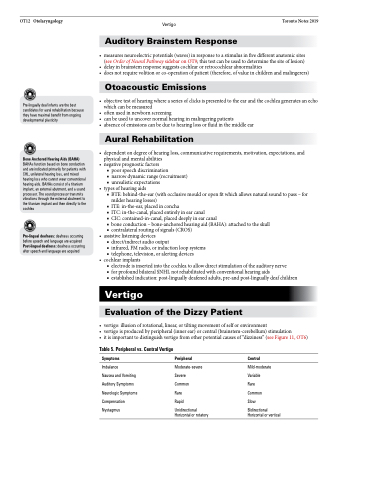Page 998 - TNFlipTest
P. 998
OT12 Otolaryngology
Pre-lingually deaf infants are the best candidates for aural rehabilitation because they have maximal benefit from ongoing developmental plasticity
Bone Anchored Hearing Aids (BAHA)
BAHAs function based on bone conduction and are indicated primarily for patients with CHL, unilateral hearing loss, and mixed hearing loss who cannot wear conventional hearing aids. BAHAs consist of a titanium implant, an external abutment, and a sound processor. The sound processor transmits vibrations through the external abutment to the titanium implant and then directly to the cochlea
Pre-lingual deafness: deafness occurring before speech and language are acquired Post-lingual deafness: deafness occurring after speech and language are acquired
Vertigo Toronto Notes 2019 Auditory Brainstem Response
• measuresneuroelectricpotentials(waves)inresponsetoastimulusinfivedifferentanatomicsites (see Order of Neural Pathway sidebar on OT9; this test can be used to determine the site of lesion)
• delayinbrainstemresponsesuggestscochlearorretrocochlearabnormalities
• doesnotrequirevolitionorco-operationofpatient(therefore,ofvalueinchildrenandmalingerers)
Otoacoustic Emissions
• objectivetestofhearingwhereaseriesofclicksispresentedtotheearandthecochleageneratesanecho which can be measured
• oftenusedinnewbornscreening
• canbeusedtouncovernormalhearinginmalingeringpatients
• absenceofemissionscanbeduetohearinglossorfluidinthemiddleear
Aural Rehabilitation
• dependentondegreeofhearingloss,communicativerequirements,motivation,expectations,and physical and mental abilities
• negative prognostic factors
■ poor speech discrimination
■ narrow dynamic range (recruitment) ■ unrealistic expectations
• types of hearing aids
■ BTE: behind-the-ear (with occlusive mould or open fit which allows natural sound to pass – for
milder hearing losses)
■ ITE: in-the-ear, placed in concha
■ ITC: in-the-canal, placed entirely in ear canal
■ CIC: contained-in-canal, placed deeply in ear canal
■ bone conduction – bone-anchored hearing aid (BAHA): attached to the skull ■ contralateral routing of signals (CROS)
• assistive listening devices
■ direct/indirect audio output
■ infrared, FM radio, or induction loop systems ■ telephone, television, or alerting devices
• cochlearimplants
■ electrode is inserted into the cochlea to allow direct stimulation of the auditory nerve
■ for profound bilateral SNHL not rehabilitated with conventional hearing aids
■ established indication: post-lingually deafened adults, pre-and post-lingually deaf children
Vertigo
Evaluation of the Dizzy Patient
• vertigo:illusionofrotational,linear,ortiltingmovementofselforenvironment
• vertigoisproducedbyperipheral(innerear)orcentral(brainstem-cerebellum)stimulation
• itisimportanttodistinguishvertigofromotherpotentialcausesof“dizziness”(seeFigure11,OT6)
Table 5. Peripheral vs. Central Vertigo
Symptoms
Imbalance
Nausea and Vomiting Auditory Symptoms Neurologic Symptoms Compensation Nystagmus
Peripheral
Moderate-severe Severe
Common
Rare
Rapid
Unidirectional Horizontal or rotatory
Central
Mild-moderate Variable
Rare
Common Slow
Bidirectional Horizontal or vertical


